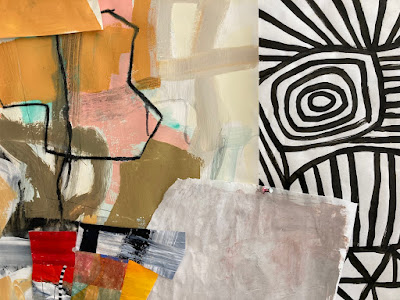It is a commonly held idea that giving ourselves time to just play, to experiment without a particular goal or expected outcome, is important to making art. [It may be important to living a healthy life, generally, as well]. But many of us, through cultural conditioning, have a hard time with this. If we know it is good for us, then maybe that makes it easier. What are your experiences with play as it pertains to your art practice or to your life?
 |
| A little visual joke on one of my Moving Targets |
As a teacher I say all the right words and give good advice regarding the necessity of play and experimentation, but am I really practicing it myself? I don't know if my work has become more work and less play, but something feels stuck or stale or in need of a re-think.
I would like to commit to a practice of play, of noticing when I am in the playful state of mind while doing creative work, and when I am not. Are there activities that can induce the play state of mind? Are there some that squash it or smother it? (Yes) My working hypotheses are:
- I will make better work if I am having fun. If I am really playing, I will discover more possibilities, more ideas, more ways of executing ideas, and ultimately my work will be better. I might make less of it (which is fine!), but it will reflect my sense of humor and my perspective more authentically.
- Cultivating and valuing that play state of mind will enable me to let go of the external voices - the imagined expectations of others - that seem to still be getting in my way (see this blog post).
- By learning how to play, I can help others (as a teacher), tap into their own playful side more effectively. Learning to play will help me be a better teacher.
I do have fun in my studio at times, and I definitely have fun teaching. I just want to pay more attention to the play and fun aspects of it all and see if I can lean into that a little more.
I would love to hear your thoughts and your experiences on this topic.
Please comment below.
Here is a post from 2018 about Art for Fun. It expresses some similar thoughts through a different lens.
 |
| OK, I do get a bit silly while teaching. That is part of the fun!! |


















































.jpg)
.jpg)
.jpg)